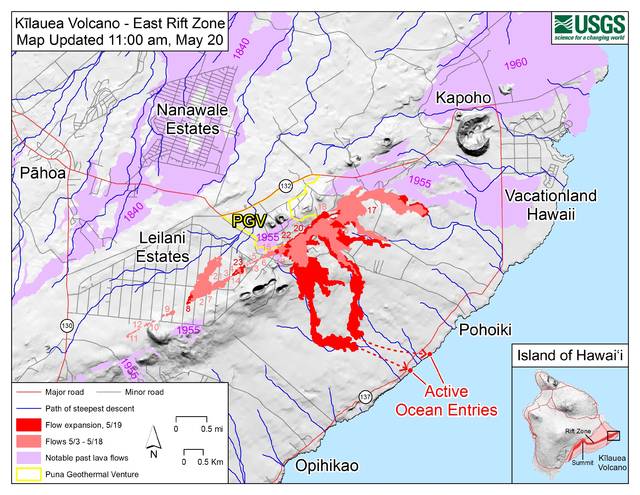“Laze,” the noxious, potentially deadly gas caused by hot lava hitting the ocean, could have a potentially widespread effect in lower Puna, according to a Hawaiian Volcano Observatory official.
Janet Babb, a volcanologist and HVO spokeswoman, said the effects of laze, which sends hydrochloric acid and steam with fine volcanic glass particles into the air, is dependent upon “the amount of lava going into the ocean and the wind direction and how strong the wind is.”
“Given the vigor of the ocean entry, the amount of lava going into the ocean and the wind direction, we estimate that the effects could reach as far as 15 miles downwind,” Babb said Sunday morning. :… Now, if the wind were stop blowing, it could spread out more like a pancake. (But) with the wind, the effects will be downwind.”
Babb said a store-bought respirator can stop the inhalation of glass particles from laze but the device won’t filter out hydrochloric acid.
Hawaiian Volcano Observatory also reports that sulfur dioxide emissions have tripled, and is warning the public to be aware of exposure to laze due to two points of ocean entry of lava off Highway 137 near MacKenzie State Park in lower Puna.
National Weather Service meteorologist Derek Wroe said current wind patterns are moderate northeasterlies or trades, and the tradewinds are forecast to continue for the next few days.
U.S Geological Survey volcanologist Wendy Stovall said a ground crack has opened in the “main eastern channel” of the fissure No. 20 complex.
“Lava is flowing down into the hole in the ground and we don’t know exactly where that lava is going nor do we know where that lava might crop up or if it will ever crop up again. There is also a hole that lava is flowing into on the westernmost side of that fissure complex,” Stovall said. “… The hole opened up in the entire width of the channel. And all of the lava that was flowing to the east from the fissure 20 complex was pouring down into the hole in the ground. We did see the same type of thing during the Kamoamoa eruption in 2011. And the lava that was pouring into the ground never reappeared at the surface.”
Stovall said seismicity “continues to be high” in the fissure areas. She also described another eruption at about 4 p.m. Friday in Halema‘uma‘u crater at Kilauea’s summit as “a pretty large explosion” associated with a magnitude-4.9 earthquake. She said it “produced an ash plume that rose up from the summit area.”
“Since that time, seismicity has tailed off,” Stovall said. “There’s been about one seismic event every hour.”
According to Stovall, lava samples from fissure 17 contain andesite, a rock not usually found in Hawaii volcanic eruptions. She said the rock’s presence could indicate that fissure’s lava could have been from magma stored underground from before the 1955 eruption, perhaps from the 1924 eruption or even an eruption in 1840.
The U.S. Coast Guard earlier this morning said it began enforcing a “lava entry safety zone” for the navigable waters surrounding the ocean entry of the lava near Mackenzie State Park.
“For mariners without prior limited entry approval, the safety zone encompasses all waters extending 300 meters (984 feet) in all directions around the entry of the lava flow into the ocean,” said Lt. Cmdr. John Bannon, Coast Guard Sector Honolulu waterways management lead. “All waterway users should be aware of the hazardous conditions associated with such an event. Getting too close to the lava can result in serious injury or death.”
Enforcement of the safety zone began today at at 8 a.m.
Highway 137 remains closed between Kamaili Road and Pohoiki Road, and Kamaili Road is closed to all through traffic.
The Department of Water Supply says an emergency water restriction is still in effect for customers between Kapoho and Pohoiki. The flow that has crossed Pohoiki Road cut off water supply to residents.
Two water tankers are providing public drinking water access to residents and visitors in Vacationland and Kapoho Beach Lots.
For an updated map of the lava activity, visit http://www.hawaiicounty.gov/2018-lava-map.



